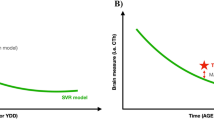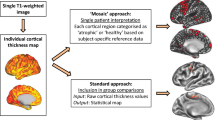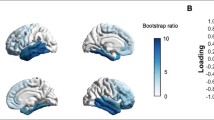Abstract
Alzheimer’s Disease (AD) is a neurodegenerative condition characterized by diverse progression rates among individuals, with changes in cortical thickness (CTh) closely linked to its progression. Accurately forecasting CTh trajectories can significantly enhance early diagnosis and intervention strategies, providing timely care. However, the longitudinal data essential for these studies often suffer from temporal sparsity and incompleteness, presenting substantial challenges in modeling the disease’s progression accurately. Existing methods are limited, focusing primarily on datasets without missing entries or requiring predefined assumptions about CTh progression. To overcome these obstacles, we propose a conditional score-based diffusion model specifically designed to generate CTh trajectories with the given baseline information, such as age, sex, and initial diagnosis. Our conditional diffusion model utilizes all available data during the training phase to make predictions based solely on baseline information during inference without needing prior history about CTh progression. The prediction accuracy of the proposed CTh prediction pipeline using a conditional score-based model was compared for sub-groups consisting of cognitively normal, mild cognitive impairment, and AD subjects. The Bland-Altman analysis shows our diffusion-based prediction model has a near-zero bias with narrow 95% confidential interval compared to the ground-truth CTh in 6-36 months. In addition, our conditional diffusion model has a stochastic generative nature, therefore, we demonstrated an uncertainty analysis of patient-specific CTh prediction through multiple realizations. Our code is available at https://github.com/siyeopyoon/Diffusion-Cortical-Thickness-Trajectory.
Q. Xiao and S. Yoon—These authors contributed equally to this paper.
A complete listing of ADNI investigators can be found at: http://adni.loni.usc.edu/wp-content/uploads/how_to_apply/ADNI_Acknowledgement_List.pdf.
Access this chapter
Tax calculation will be finalised at checkout
Purchases are for personal use only
Similar content being viewed by others
References
Che, Z., Purushotham, S., Cho, K., Sontag, D., Liu, Y.: Recurrent neural networks for multivariate time series with missing values. Scientific reports 8(1), 6085 (2018)
Desikan, R.S., et al.: An automated labeling system for subdividing the human cerebral cortex on mri scans into gyral based regions of interest. Neuroimage 31(3), 968–980 (2006)
Gennatas, E.D., et al.: Age-related effects and sex differences in gray matter density, volume, mass, and cortical thickness from childhood to young adulthood. Journal of Neuroscience 37(20), 5065–5073 (2017)
Hwang, J., et al.: Prediction of alzheimer’s disease pathophysiology based on cortical thickness patterns. Alzheimer’s & Dementia: Diagnosis, Assessment & Disease Monitoring 2, 58–67 (2016)
Jung, W., Jun, E., Suk, H.I., Initiative, A.D.N., et al.: Deep recurrent model for individualized prediction of alzheimer’s disease progression. NeuroImage 237, 118143 (2021)
Karras, T., Aittala, M., Aila, T., Laine, S.: Elucidating the design space of diffusion-based generative models. Advances in Neural Information Processing Systems 35, 26565–26577 (2022)
Kim, B.H., et al.: Large-scale graph representation learning of dynamic brain connectome with transformers. arXiv preprint arXiv:2312.14939 (2023)
Kim, J., et al.: Distinct spatiotemporal patterns of cortical thinning in alzheimer’s disease-type cognitive impairment and subcortical vascular cognitive impairment. Communications Biology 7(1), 198 (2024)
Li, X., Guo, N., Li, Q.: Functional neuroimaging in the new era of big data. Genomics, Proteomics and Bioinformatics 17(4), 393–401 (2019)
Marinescu, R.V., et al.: Dive: A spatiotemporal progression model of brain pathology in neurodegenerative disorders. NeuroImage 192, 166–177 (2019)
Pérez-Millan, A., et al.: Cortical thickness modeling and variability in alzheimer’s disease and frontotemporal dementia. Journal of Neurology pp. 1–11 (2023)
Reuter, M., Schmansky, N.J., Rosas, H.D., Fischl, B.: Within-subject template estimation for unbiased longitudinal image analysis. Neuroimage 61(4), 1402–1418 (2012)
Schwarz, C.G., et al.: A large-scale comparison of cortical thickness and volume methods for measuring alzheimer’s disease severity. NeuroImage: Clinical 11, 802–812 (2016)
Xu, L., et al.: Multi-modal sequence learning for alzheimer’s disease progression prediction with incomplete variable-length longitudinal data. Medical Image Analysis 82, 102643 (2022)
Yang, L., et al.: Diffusion models: A comprehensive survey of methods and applications. ACM Computing Surveys 56(4), 1–39 (2023)
Yang, Z., et al.: A deep learning framework identifies dimensional representations of alzheimer’s disease from brain structure. Nature communications 12(1), 7065 (2021)
Yi, F., et al.: Identifying underlying patterns in alzheimer’s disease trajectory: a deep learning approach and mendelian randomization analysis. Eclinicalmedicine 64 (2023)
You, P., et al.: Characterization of brain iron deposition pattern and its association with genetic risk factor in alzheimer’s disease using susceptibility-weighted imaging. Frontiers in Human Neuroscience 15, 654381 (2021)
Zhao, X., et al.: Multi-size computer-aided diagnosis of positron emission tomography images using graph convolutional networks. In: 2019 IEEE 16th International Symposium on Biomedical Imaging (ISBI 2019). pp. 837–840. IEEE (2019)
Zhou, J., et al.: Modeling disease progression via multi-task learning. NeuroImage 78, 233–248 (2013)
Acknowledgments
This study was funded by National Natural Science Foundation of China (grant number U22A20350). Data collection and sharing for the Alzheimer’s Disease Neuroimaging Initiative (ADNI) is funded by the National Institute on Aging (National Institutes of Health Grant U19 AG024904). The grantee organization is the Northern California Institute for Research and Education. More details about the funding sources of ADNI can be found at https://adni.loni.usc.edu/wp-content/uploads/how_to_apply/ADNI_Data_Use_Agreement.pdf.
Author information
Authors and Affiliations
Consortia
Corresponding authors
Editor information
Editors and Affiliations
Ethics declarations
Disclosure of Interests
The authors have no competing interests to declare that are relevant to the content of this article.
Rights and permissions
Copyright information
© 2024 The Author(s), under exclusive license to Springer Nature Switzerland AG
About this paper
Cite this paper
Xiao, Q. et al. (2024). Conditional Score-Based Diffusion Model for Cortical Thickness Trajectory Prediction. In: Linguraru, M.G., et al. Medical Image Computing and Computer Assisted Intervention – MICCAI 2024. MICCAI 2024. Lecture Notes in Computer Science, vol 15002. Springer, Cham. https://doi.org/10.1007/978-3-031-72069-7_8
Download citation
DOI: https://doi.org/10.1007/978-3-031-72069-7_8
Published:
Publisher Name: Springer, Cham
Print ISBN: 978-3-031-72068-0
Online ISBN: 978-3-031-72069-7
eBook Packages: Computer ScienceComputer Science (R0)





